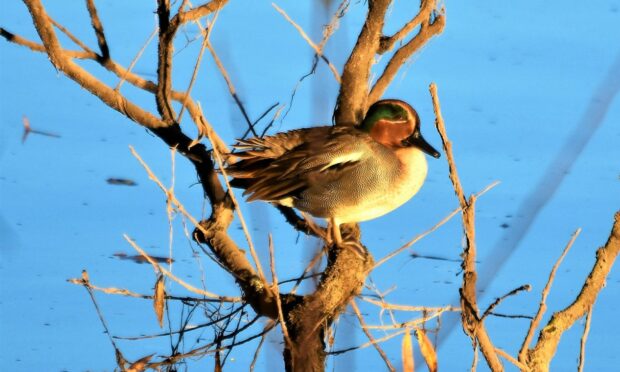Using a pair of trail cameras, I have been monitoring a shallow offshoot creek of my local river where a diverse array of wildlife was captured on film.
Teal were the principal stars that appeared daily.
They adore this little creek because the calm, shallow confines act like an oasis where they can feed safely on the rich muddy bottom by up-ending continuously.
Delightful little ducks
Teal are delightful little ducks that are active both by day and night.
A small group of female goldeneye ducks also appeared on the camera one day.
They are scarce winter visitors to this river, but when the weather gets cold and nearby lochs freeze over, a few always materialise to take advantage of the fast-flowing and ice-free water.
Herons regularly showed up, stalking in the shallow margins with slow and cautious movements as they carefully scrutinised the water for fish.
An otter briefly materialised on one of the videos, quickly skirting the edge of a pool, its back undulating in a sinuous and weasel-like movement.
Otter droppings
Otters are doing well on the river but are seldom seen because of their mainly nocturnal and secretive habits.
However, when walking river banksides, it is easy to see their scent-marking sites where they have deposited their tarry-like spraints (droppings) on top of prominent locations such as rocks, tree stumps or small hummocks.
A water rail – one of our most elusive water birds – made a cameo appearance.
Like the otter, water rails are more commoner than one might imagine and lurk in reed-beds or among thick tangles of waterside vegetation making them very difficult to spot.
I was also thrilled to have secured several clips of snipe feeding in the shallows.
The snipe, which is a small and long-billed wading bird, is a master of concealment and it was wonderful to get a glimpse into their secretive lives.
In one instance, the camera filmed a pair where one bird tried to mount the other as if mating.
It is far too early in the season for mating to occur, but the clip did reveal that spring is maybe not as far away as one might imagine.
Probing bill
The most fascinating piece of film, however, was a snipe catching a brook lamprey.
At this time of year, slowly maturing brook lampreys live under the sediment of rivers and have the size and appearance of small eel, only about 10 cm to 14 cm long.
This feeding snipe hit the jackpot and pulled the wriggling lamprey out from its muddy lair with its long and probing bill.
The snipe wrestled with the lamprey for several seconds before swallowing it with a satisfied gulp.
I knew brook lampreys lived in this pool and had previously glimpsed them emerging as adults in early spring after having spent a few years under the mud as filter-feeding larvae.
Brook lampreys are fascinating fish that encapsulate the very beating heart of our rivers – mysterious and alluring, and with a never-ending capacity to surprise.




Conversation